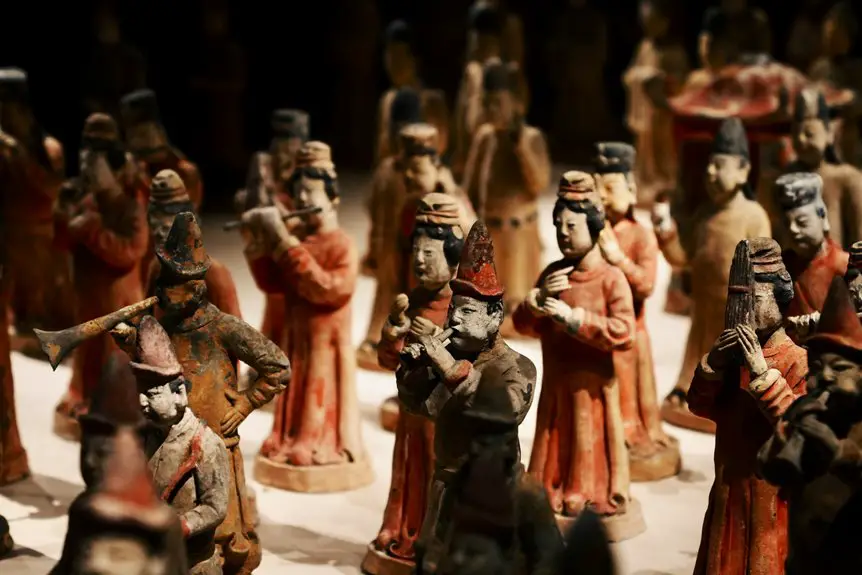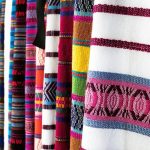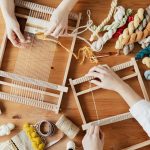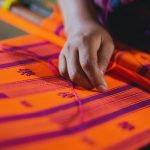A double ikat is a rare and intricate textile technique where both the warp and weft threads are resist-dyed before weaving, creating precise and symmetrical patterns. You’ll appreciate its complexity, as aligning dyed threads demands immense skill, patience, and meticulous planning. This labor-intensive craft carries deep cultural significance and produces stunning, unique fabrics prized by collectors and designers alike. If you want to understand why double ikat weaves together artistry, heritage, and craftsmanship so beautifully, there’s much more to discover.
Table of Contents
Key Takeaways
- Double ikat is a textile technique where both warp and weft threads are resist-dyed before weaving, creating intricate, symmetrical patterns.
- It originated independently in India, Indonesia, and Japan, each with unique cultural symbolism and styles.
- The process demands extreme skill, patience, and precision to align dyed threads perfectly, making it technically complex.
- Double ikat fabrics carry deep cultural significance, often used in ceremonies and symbolizing status and heritage.
- Due to its labor-intensive creation and rarity, double ikat is highly valued by collectors and designers as a unique art form.
The Origins and History of Double Ikat
Although double ikat is known for its intricate patterns, its origins reveal a rich cultural heritage that dates back centuries.
When you explore its history, you’ll find that double ikat emerged independently in several regions, including India, Indonesia, and Japan. Each culture developed its own unique style and symbolism, reflecting local traditions and beliefs.
For example, in India’s Patan region, double ikat was reserved for royalty and special ceremonies, showing its significance. You’ll also see that the technique’s complexity made it a symbol of status and craftsmanship.
Understanding the Double Ikat Weaving Technique
Mastering the double ikat weaving technique requires patience and precision, as artisans dye both the warp and weft threads before weaving.
You start by carefully tying sections of threads with resist material, marking where the dye shouldn’t penetrate. This process repeats for multiple colors and patterns on both sets of threads, demanding meticulous alignment.
When you weave, the dyed patterns on the warp and weft intersect perfectly, creating intricate, crisp designs. Unlike single ikat, where only one thread set is dyed, double ikat’s complexity makes the finished fabric highly prized.
You must control tension, timing, and color application flawlessly to achieve the signature clarity and symmetry. This technique turns weaving into a complex dance between dyeing and threading, requiring skill passed down through generations.
Materials and Tools Used in Double Ikat Production
When you start working with double ikat, you’ll rely on traditional fibers like cotton and silk for the yarns.
You’ll also need specific tools, such as looms and dyeing equipment, to create those intricate patterns.
Understanding these materials and tools is key to mastering the craft.
Traditional Fibers and Yarns
Fibers like cotton and silk form the foundation of double ikat textiles, chosen for their durability and ability to absorb vibrant dyes. When you work with cotton, you get a sturdy yet soft fabric that holds patterns well.
Silk, on the other hand, adds a luxurious sheen and smooth texture, making the finished textile feel elegant and rich. You’ll also find artisans using natural yarns spun by hand, which keeps the fabric authentic and connected to traditional methods.
These yarns vary in thickness and twist, affecting the final pattern’s clarity. By selecting the right fiber and yarn, you guarantee your double ikat piece not only looks stunning but also lasts through generations, preserving the art and culture embedded in every thread.
Essential Weaving Equipment
Although double ikat weaving demands patience and skill, having the right tools makes the process manageable and enjoyable.
You’ll need a sturdy loom, often a traditional backstrap or pit loom, which holds your threads taut for precise weaving. Before weaving, you’ll prepare your yarns with resist dyes, using binding materials like rubber bands or tightly wound threads to create patterns.
Sharp scissors and needles help you adjust threads and manage intricate tying. A dyeing vat is essential for applying color exactly where you want it. Finally, a measuring stick or gauge guarantees your patterns stay consistent.
With these tools, you can control the complex alignment of both warp and weft threads, bringing the double ikat’s mesmerizing designs to life.
Step-by-Step Process of Creating Double Ikat Fabric
Before you plunge into creating double ikat fabric, you need to understand that the process demands meticulous planning and precision.
First, you design the pattern, deciding how the motifs will align on both warp and weft threads.
Next, you tightly bind sections of these threads with resist materials to prevent dye absorption in targeted areas.
Then, you carefully dye the threads, often repeating the binding and dyeing multiple times to achieve complex color layers.
After dyeing, you remove the bindings and set the threads onto the loom, making sure the dyed patterns precisely match.
Finally, you weave the fabric slowly, maintaining alignment so the double ikat design emerges vividly.
Each step requires patience and skill to create this rare, intricately patterned textile.
Cultural Significance and Symbolism in Double Ikat Patterns
You’ll notice that double ikat patterns carry deep symbolic meanings through their unique motifs.
These designs often play a key role in ceremonies and rituals, reflecting the beliefs of the community.
Symbolic Motifs and Meanings
Symbols in double ikat patterns carry deep cultural meanings that connect you to the heritage and beliefs of the communities who create them. Each motif tells a story or conveys values like protection, prosperity, or spiritual harmony. Understanding these symbols lets you appreciate the artistry beyond aesthetics and see the fabric as a living tradition.
| Motif | Meaning |
|---|---|
| Fish | Fertility and abundance |
| Lotus | Purity and enlightenment |
| Diamond | Protection and strength |
| Wave | Continuity and life force |
| Bird | Freedom and spirituality |
When you wear or see double ikat, you’re embracing centuries of symbolism woven into every thread, making it much more than just fabric.
Ceremonial and Ritual Uses
The meaningful motifs woven into double ikat patterns don’t just decorate the fabric—they play an essential role in ceremonies and rituals.
When you wear or use a double ikat, you’re tapping into centuries of cultural symbolism, where each design carries blessings, protection, or status. People often reserve these textiles for weddings, religious events, or important rites of passage, believing the patterns connect them to ancestors or spiritual forces.
You’ll notice that specific motifs can signify prosperity, fertility, or harmony, making the fabric a powerful talisman in ceremonies. By embracing double ikat during these moments, you honor tradition and invite positive energy.
Regional Cultural Identities
Although double ikat patterns vary widely across regions, each design reflects the unique cultural identity and history of its origin. When you explore these textiles, you’ll notice how symbols and motifs convey stories, beliefs, and status. Understanding these elements helps you appreciate the deep cultural significance embedded in every thread.
| Region | Symbolic Meaning |
|---|---|
| India (Patola) | Prosperity, fertility, and protection |
| Indonesia (Bali) | Spirituality, ancestral connection |
| Japan | Status, family heritage |
| Central Asia | Tribal identity, natural elements |
Regions Around the World Known for Double Ikat
Double ikat captivates many with its intricate patterns and labor-intensive process, and you can find this exquisite art form in select regions worldwide.
Double ikat enchants with intricate patterns and meticulous craftsmanship, flourishing in rare, culturally rich regions worldwide.
In Indonesia, particularly in Bali and the island of Sumba, double ikat is a revered tradition, showcasing bold, geometric designs.
India’s Patan region in Gujarat is another hotspot, famous for its Patola sarees woven with vibrant motifs.
Meanwhile, Japan offers its own take with the exquisite Oshima Tsumugi, known for delicate, subtle patterns.
Each region brings unique cultural influences and techniques, making their double ikat textiles distinct.
When you explore these areas, you’ll witness how this rare weaving art continues to thrive, reflecting centuries of heritage and craftsmanship that few other textile traditions can match.
Challenges and Time Investment in Making Double Ikat
When you plunge into creating double ikat, you’ll quickly realize how demanding the process is, requiring immense skill and patience.
Aligning dyed threads perfectly before weaving is a monumental challenge that can take months. You must master precise resist-dyeing techniques on both warp and weft threads, ensuring the pattern matches flawlessly.
Here are key challenges and time investments you’ll face:
- Designing intricate patterns that require detailed planning.
- Tying resist threads meticulously to create precise dye areas.
- Repeated dyeing and drying cycles to achieve vibrant colors without bleed.
- Weaving with extreme accuracy to maintain pattern alignment throughout the fabric.
This painstaking process tests your dedication, but the stunning results make every hour worth it.
Why Collectors and Designers Value Double Ikat So Highly
Since you can immediately see the complexity and craftsmanship behind double ikat, collectors and designers prize it for its rarity and artistic value.
You recognize that each piece involves meticulous planning and skill, making it a unique work of art rather than just fabric. Its intricate patterns, perfectly aligned on both warp and weft threads, demonstrate mastery few textiles achieve.
When you own or work with double ikat, you’re engaging with a tradition that’s both culturally rich and technically demanding.
Designers appreciate how it elevates their collections, adding depth and authenticity. Collectors value it as an investment, knowing its scarcity and handcrafted nature make it a timeless treasure.
Ultimately, double ikat’s blend of artistry and heritage captivates you, making it highly sought after.
Frequently Asked Questions
How Should I Care for and Clean Double Ikat Fabrics?
You should hand wash double ikat fabrics gently in cold water with mild detergent. Avoid wringing or twisting, and air dry in the shade. Iron on low heat to preserve colors and delicate patterns.
Can Double Ikat Patterns Be Customized or Designed on Demand?
You’re in for a delightful challenge! While double ikat patterns aren’t your everyday DIY project, skilled artisans can tailor designs to your taste, blending tradition with your vision—though it takes time and patience to achieve.
Are There Modern Innovations in Double Ikat Weaving Techniques?
You’ll find modern innovations like digital tools helping design intricate patterns and eco-friendly dyes enhancing sustainability. Artisans also experiment with blending traditional weaving with contemporary materials, keeping double ikat vibrant and relevant in today’s textile world.
What Is the Average Cost Range of Authentic Double Ikat Textiles?
Imagine holding a vibrant, intricately patterned textile—authentic double ikat can cost anywhere from $500 to over $5,000. You’ll find prices vary greatly based on origin, craftsmanship, and rarity, reflecting its painstaking creation.
How Can I Authenticate Genuine Double Ikat Versus Imitation Fabrics?
You can authenticate genuine double ikat by examining the fabric’s intricate, precise patterns on both sides, feeling the handwoven texture, and verifying the natural dyes. Consulting experts or certificates also helps avoid imitations.
- What Is a “Double Ikat” and Why Is It so Prized? - June 28, 2025
- Understanding Ikat From Telangana and Orissa, India - June 28, 2025
- A Guide to Thai Ikat: The Art of Mudmee Silk - June 28, 2025







